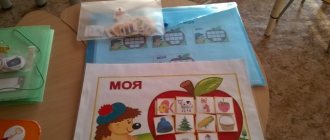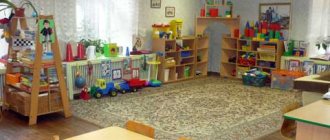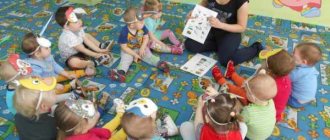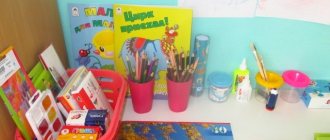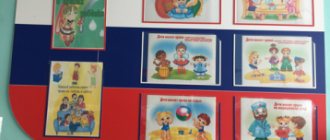Design of the speech development center
The speech development center is equipped and staffed in accordance with the age of the pupils. Thus, every year it is transformed and enriched to make it interesting and productive for children to study here.
For younger preschoolers, the speech development corner may include a sensory area - a place for the development of fine motor skills. As an option, this is a table with educational games: pyramids, a sorter, books and toys with buttons, bags of seeds and pebbles.
This could be a rug on the wall with buzzers, rubber bands, a plastic mirror, buttons, felt pictures, ribbons, and Velcro. The sensory mat usually depicts the plot of a fairy tale familiar to children (“Turnip”, “Teremok”, “The Three Little Pigs”) or images of natural objects, animals: flowers, trees, butterflies, birds, bunnies, etc. Everyone knows that a child’s first he actually wants to touch the object that interests him, so a developmental rug is made from pieces of bright fabric, scraps of velvet, printed ribbon, and colorful braid.
For all age groups of preschoolers, objects and play sets for the development of speech breathing should be presented in the corner. For these purposes, waste material and simple toys are used: plastic tubes and cups, ping-pong balls, cotton balls, plumes and pinwheels, flags, balloons. The teacher includes breathing exercises in play activities.
In the speech corner of the senior and preparatory groups, a place is set up for board and printed games. The selection is made up of games with letters and words:
- “Entertaining ABC”: for cards with letters (uppercase and printed), you need to select cards with images of objects for these letters. “ABC Lotto”: cards with beeches are filled with chips with animals whose names begin with these letters. “Kaleidoscope of Letters”: children learn to recognize the symbolic designations of letters on the playing field. “Make a word. Dominoes: cards are used to create an image and its name. “Who lives where”: cards with words, animals and their habitats.
To stimulate children's verbal creativity and play dramatization games, a small area with a screen, decorations, and dolls is set up in the corner. Unlike the theatrical activity corner, the space for performances in the speech corner is limited. For example, you can cover a cardboard box - it will be a fairy-tale forest for the figurines. Dialogue using hand puppets and bibabo can be acted out from behind a folding paper screen.
Requirements for the speech development corner according to the Federal State Educational Standard for Preschool Education
Optimal location: the corner is sufficiently lit, located in a quiet place next to the book, theater and sensory development corners.
Compliance with the age and individual needs of children. The presence of an animated character - a doll or toy. The character who owns the corner encourages children to engage in speech activity: he tells funny stories, invites them to play, and asks questions. With the help of an animated toy, motor exercises and articulatory gymnastics are demonstrated. Aesthetics. The corner is designed in the same style as the areas for artistic reading and theatrical activities. The place of study attracts not only with bright colors, but also with interesting objects: reproductions on the wall, figurines on the shelf. Didactic and gaming materials are located in a corner by topic, and students learn to maintain order. Safety. Pupils of the first and second junior groups independently practice the development of fine motor skills under the supervision of a teacher (due to the danger of small parts getting into the respiratory tract). It is not recommended to equip the speech corner with hanging shelves or cabinets with glass doors. Electrical appliances and power supplies must be out of the reach of children. Names of the speech development center
The name of the developmental activity corner in kindergarten should be short and understandable. Traditionally, the activity center is named after the actual focus of the activity. Since a mandatory attribute of a speech corner is an animated toy, the name of this fantasy character is often used in the name. Unusual and funny names arouse additional interest among students. You can arrange a competition for children and parents to come up with a name.
- Classic names: “Speech Corner”, “Speech Coach”, “Speech Development Corner”, “Learning to Talk”, “Speech Development Lessons”.
Titles with the name of the owner of the corner: “Lessons of Aunt Owl”, “Hello, Dunno!”, “Visiting Luntik”, “Button Invites”, “Talker”, “Mushka the Talker”, “Bunny the Lopotushka”.
Funny names: “Let's Talk”, “Gazebo”, “Zvukarik”, “Govoryashka/Govorusha”, “Azbukvarik”, “ABVGDEyka”, “Govorilki”, “Logostrana”, “Let’s Sit and Talk”, “Rechetsvetik”.
Contents of the speech development center
A special place in the speech corner is given to the animated character. The kids talk with this toy or picture in a playful way, he “sends” them parcels with new games and letters with tasks.
For the children's activity center, environmentally friendly (plastic, wooden, upholstered) furniture is selected. Cabinets, chairs and tables should be comfortable and suitable for the height of children. Sample list of furniture for a speech corner:
- Wardrobe/rack with shelves. Table or shelf for temporary exhibitions. Desk and chairs.
Equipment in the speech development corner:
Mirror. To perform articulation exercises, the child needs to monitor his facial expressions, learn to independently control and direct his actions. The mirror should be securely mounted on the wall and located at the work desk, firstly, it is convenient for the child during class, and secondly, this eliminates the risk that children will accidentally touch the mirror and it will fall.
Audio recorder, TV. One of the components of speech development in kindergarten is enriching the auditory experience of pupils. Children hear literate speech, correct pronunciation, and logically constructed statements—their culture of oral communication is formed. For this purpose, audio tales and recordings of artists reading poems are listened to in the speech corner. Watching short videos serves as material for building further conversation.
Magnetic board. As mentioned above, such a board can be used to post current information, display photographs and illustrations on the topic of the lesson. But more often it is used for students to perform exercises. For example, in the following tasks: “Arrange the pictures in the correct sequence to form the plot of a fairy tale. Try to retell it,” “Make words from the letters of the magnetic alphabet...”, “Distribute the pictures by topic, come up with a name for each of them.”
Composition of the material base of the speech development corner
| Visual materials, manuals |
|
| Materials for sensory development |
|
| Items for breathing development |
|
| Didactic materials |
|
| Materials for dramatization games |
|
